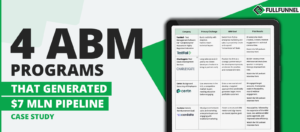In this case study, I’ll dive into the behind-the-scenes details of a demand generation strategy for software development company Postindustria that generated:
- 9 enterprise qualified sales opportunities
- 3 new contracts with 10x ACV (annual contract value)
But aside from the revenue results, they gained way more important benefits for their business:
- A proven and effective process they are replicating now in another vertical to scale revenue
- Unique positioning and recognizable brand in the AdTech vertical that helps them step out from the competition on the overcrowded software development market
- Powerful network and connections that are generating inbound opportunities for them.
Table of Contents
ToggleStage 1: ABM strategy to grow revenue by 50%
Before working with us, Postindustria was growing through referrals and could offer competitive rates. As the market evolved, prices went up, the company grew and was eventually acquired by a larger business.
Their new target was to grow revenue by 50% comparing to the previous year.
To meet the ambitious target in a changing market, the company asked us to develop a new go-to-market strategy with a more scalable way of acquiring the new businesses.
Step 1: Narrowing down the target market and positioning
Before we started working together, Postindustria operated in a broad and highly competitive market of software development. It’s extremely hard to stand out in the marketplace with such a generic positioning, so we decided to narrow it down to two axes:
- Target segment: we started by analyzing their best customers and identified Ad Tech as the most profitable segment
- Expertise area: we decided to narrow down our positioning to mobile bidding expertise and mobile SDK development
Note that while the company was able to provide different solutions to various industries, the narrow target segment and positioning enabled us to get much higher response rates and eventually win much larger contracts (10X of the previous ACV).
Additional resources:
- For more details on the framework for B2B marketing strategy development, check out this guest post for Sales Hacker.
- For more details on market positioning, check out our guide on positioning.
Step 2: The ABM pilot campaign and the black swan event
Initially, we decided to launch an account-based marketing campaign to prospect and generate sales opportunities with strategic accounts from AdTech.
The first step was to set up a small-scoped pilot campaign to see the market feedback and identify what should be improved in our message.
Short note:
Small-scoped campaigns are crucial because if you are doing ABM for the first time, mistakes are inevitable.
You need to identify how your message resonates with strategic accounts, what are the objections and concerns, what are the disqualification criteria you’d consider when building a list of target campaigns.
After several iterations, you’ll have a good scalable process.
Coming back to the ABM campaign.
We worked together with Postindustria on account selection and disqualification criteria, trained the team on account list building, and account research.
Next step was preparing personalized pitches to every buying committee member from strategic accounts when the first Covid-19 lockdown happened across the US.
We had to pause the campaign and needed to quickly develop an alternative strategy to generate sales-qualified opportunities.
ABM resources:
- For a deep dive into our account-based marketing process and 4 different ABM campaigns you can launch on a shoestring budget with minimum resources just in 6 weeks, check out our 6-Weeks ABM Playbook
Step 3: Demand generation strategy on LinkedIn
As an alternative to the paused ABM campaign, we decided to launch a demand generation campaign on LinkedIn.
The key idea was to involve into thought leadership and social selling Postindustria’s CEO and CMO, plus active peer engagement from senior developers.
There were several reasons:
- Everybody started to heavily invest in ads, so the CPC drastically increased
- To save the bottom line, almost everybody in software development market doubledowned on cold outreach.
These desperate attempts to grab the attention of strategic accounts proved us that when everybody zigs, you should zag.
The key goals for our demand generation strategies were:
- Connect, establish relationship and warm-up strategic accounts on LinkedIn
- Showcase Postindustria’s niche expertise in AdTech and mobile SDK
- Develop a recognizable brand
- Create demand for their service
Launching demand generation strategy takes a longer time but the benefits are priceless. One of them is compound effect.
At one point you start seeing more referrals, more brand mentions, more media appearances, more opportunities, and, as a result, more revenue.

How lead generation scales vs how demand generation scales
Stage 2: Launching demand generation strategy on LinkedIn
As I mentioned above, we have defined 3 pillars for our demand generation strategy:
- Proactively connecting with the buying committee members from strategic AdTech companies
- Demand creation through thought leadership
- Social selling
We call this process LinkedIn Allbound Marketing which is presented below as a simple demand generation funnel.
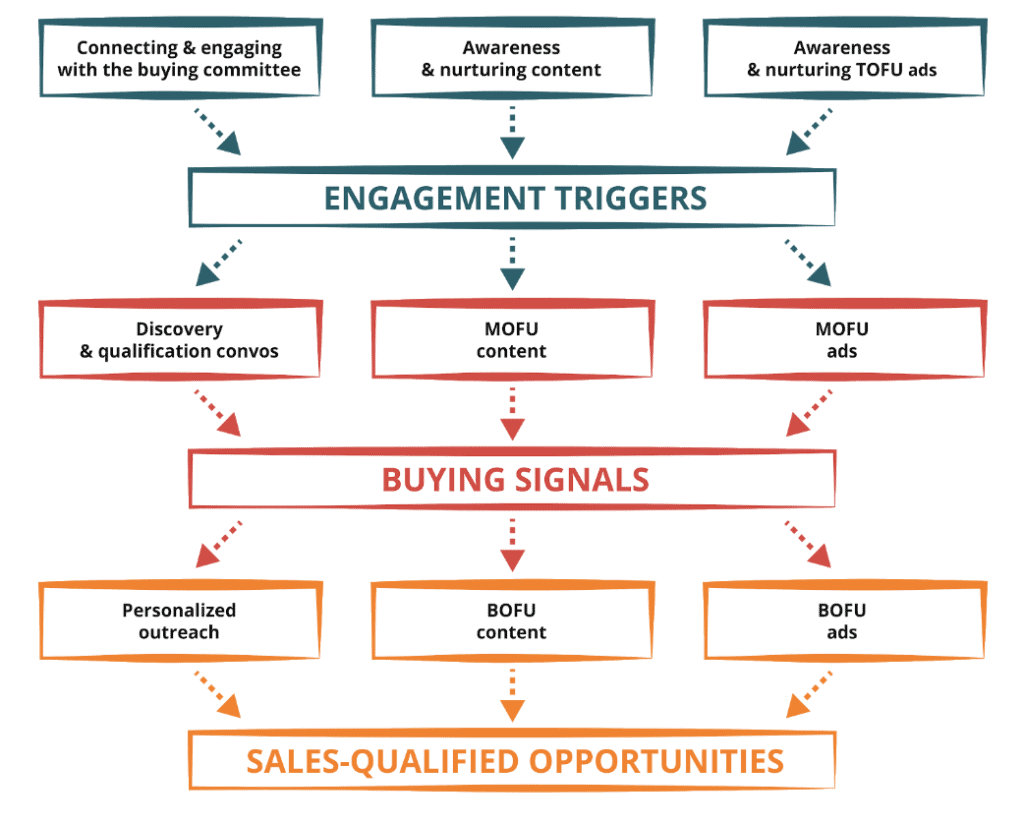
Here are the key elements of the LinkedIn demand generation and social selling strategy:
- Turn your LinkedIn profile into a landing page
- Consistently grow your network with 4 audiences
- Warm up & nurture target accounts
- Turn engagement & buying signals into conversations and opportunities
- Never stop nurturing
In the next sections, I’ll show you how we implemented steps 1-3 with Postindustria’s team, and in the bonus section, we’ll share some ideas and best practices for steps 4 & 5.
1. Turn your LinkedIn profile into a landing page
Here are two biggest mistakes people make with LinkedIn profiles.
Mistake #1: Lack of clear positioning to a narrow audience.
“You cannot be everything to everyone. If you decide to go north, you cannot go south at the same time.” – Jeroen De Flander.
You want to get known by a specific audience (e.g. fintech SaaS) for helping them achieve a desirable result (e.g. reduce churn) better than others in the market (e.g. by 20%).
See how Postindustria’s CEO is narrowly positioned both in terms of audience (AdTech) and expertise (monetization SDK and header bidding).
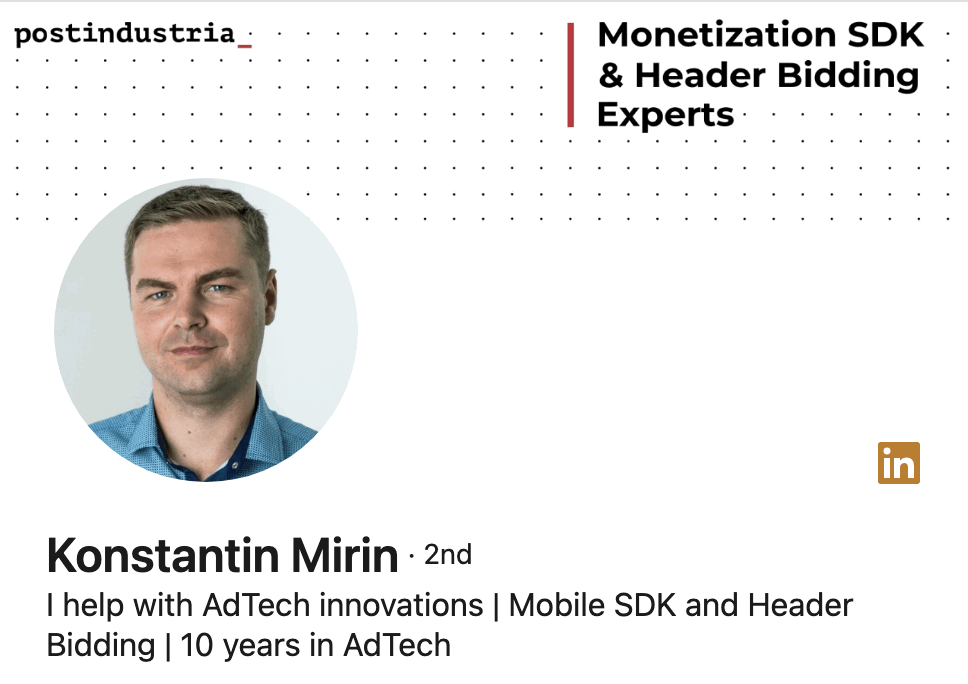
Use your LinkedIn profile to communicate your positioning
Mistake #2: Treating your LinkedIn profile as a resume, instead of a landing page.
Your LinkedIn profile is your key piece of LinkedIn real estate.
When you become active on Linkedin, thousands of people will see your profile. People will look at your profile to decide if they want to accept your connection request, follow you — or consider working with you.
That’s why you need to treat your profile as a high-converting landing page. It should convey your positioning and value proposition, share social proof, demonstrate what you can accomplish for your prospects and call them to action.
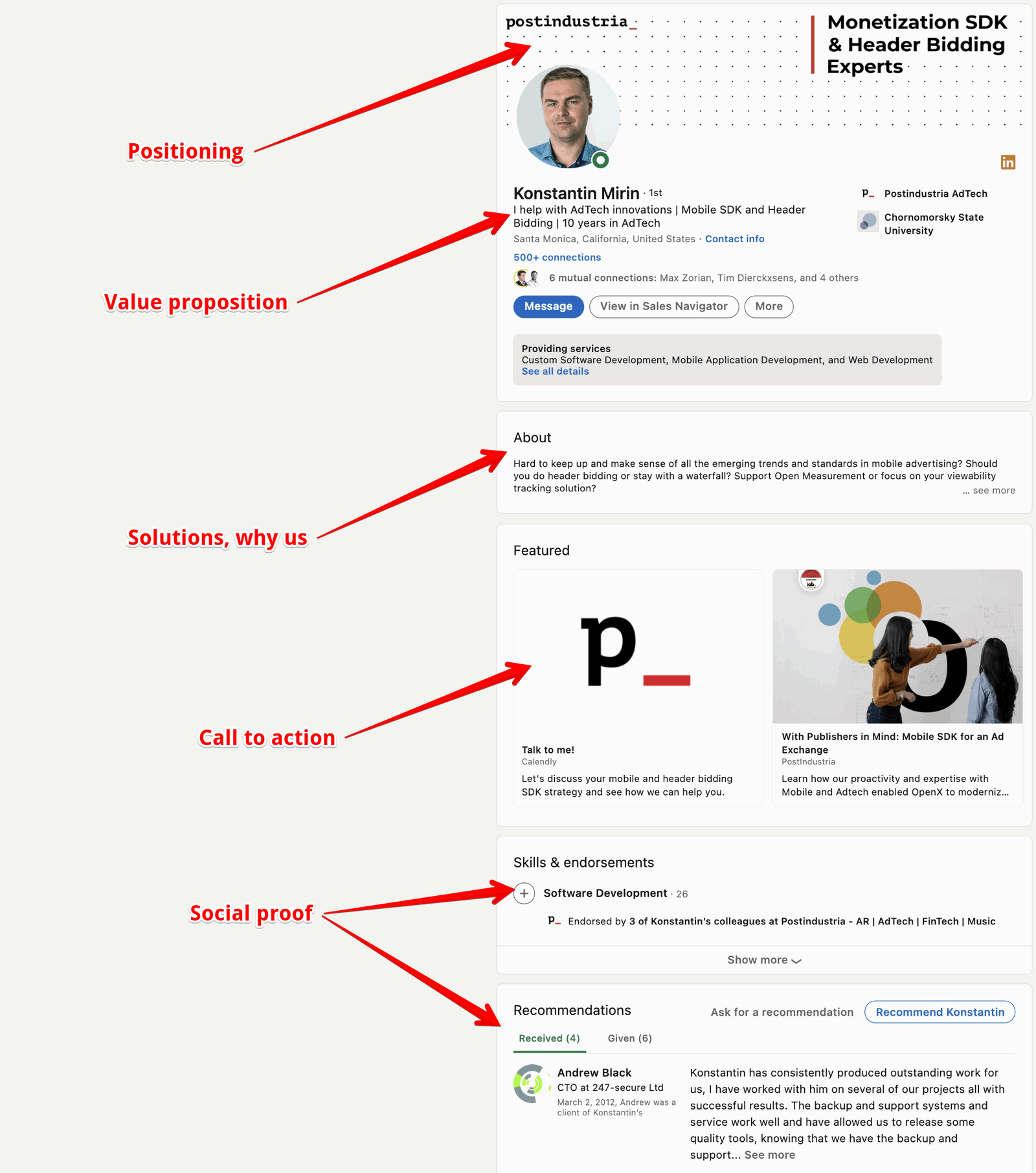
Treat your LinkedIn profile as a landing page
What about the business LinkedIn page?
Postindustria created a new LinkedIn page with a narrow positioning for AdTech and added to the profiles of the team members focused on developing this market.

Niche-focused business page on LinkedIn (in addition to the main business page)
2. Consistently grow your network with 4 audiences
When it comes to network building, many B2B businesses make four critical mistakes.
Mistake #1: broad targeting.
Driven by FOMO (fear of missing out), some companies reach out to anyone who could be a user of your product. But he who chases two rabbits, catches none.
But even when they realize they should be targeting specific niches, they still build large lists.
For example, initially Postindustria built a list of 200 companies. But we didn’t have the resources to prospect 200 businesses.
We added more disqualification criteria to narrow down the focus and ended up with 15 accounts.
Mistake #2: Prospecting the decision-makers only.
According to Harvard Business Review, the number of people involved in B2B solutions purchases has climbed from an average of 5.4 to 6.8 back in 2017.
Nowadays, buyers take longer to decide, involving even more people than before.
By connecting to different members of the buying committee, you’ll gain a deeper understanding of the needs and objections of the accounts and be able to better influence the different buyers.
Because Postindustria was prospecting enterprise companies, we had 7-10 buying committee members per account and ended up with a list of 100 target LinkedIn profiles.
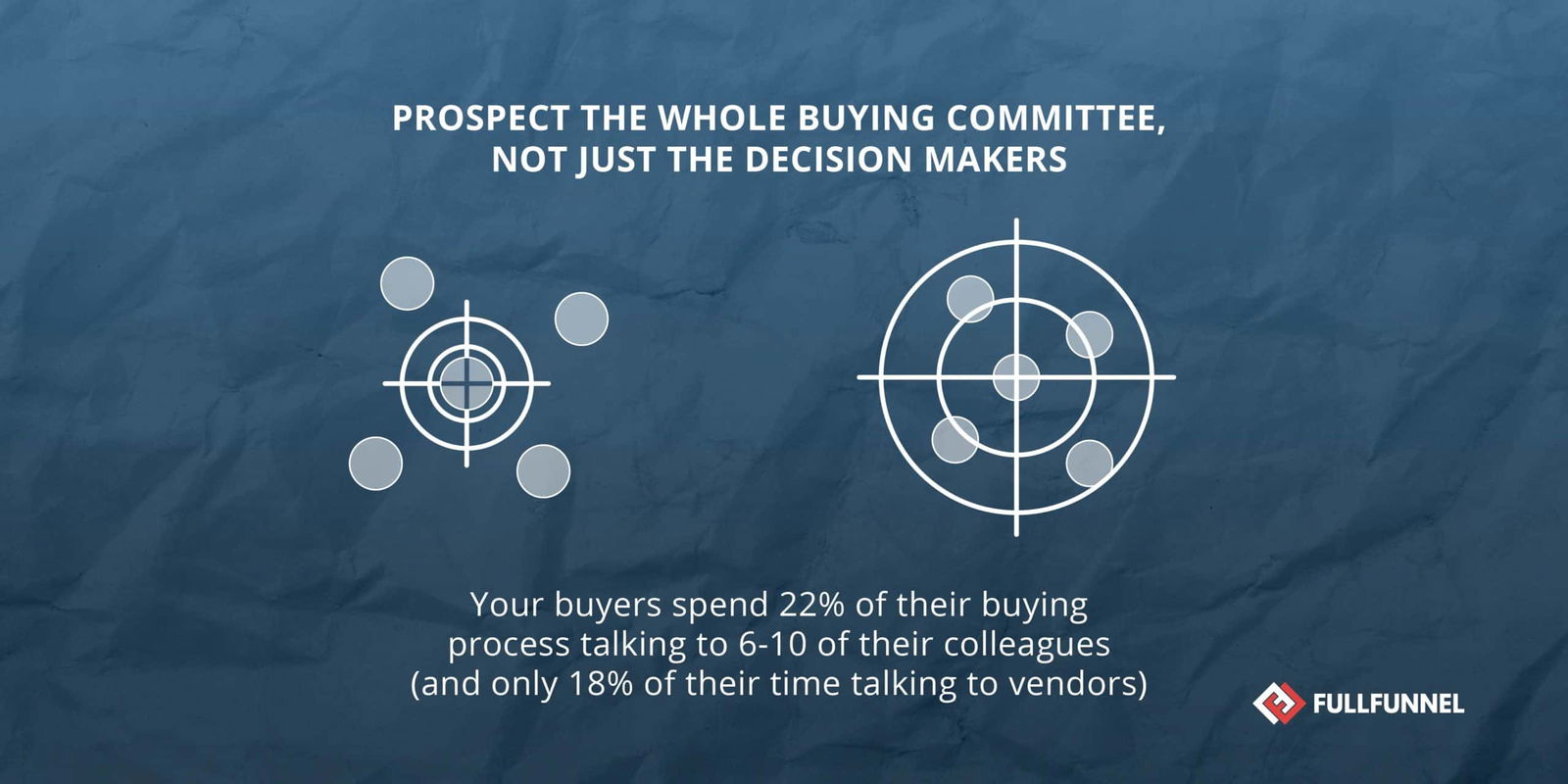
Mistake 3: Only connecting with potential customers.
Connecting to prospects fitting your Ideal Customer Profile is a must. But if that’s all you, you’ll miss out on three more important message-amplifying audiences:
Engagers – People who are highly active on content, love your content, but will never buy from you.
Asset owners – These are the people that are doing thought leadership and are followed by your target audience, run communities, niche blogs or newsletters and can help to expand your reach.
Co-pilots – People who serve the same audience but sell different solutions to your ICP.
For Postindustria, one of the key goals was establishing relationship with OpenX that has the largest independent ad exchange network for publishers and demand partners.
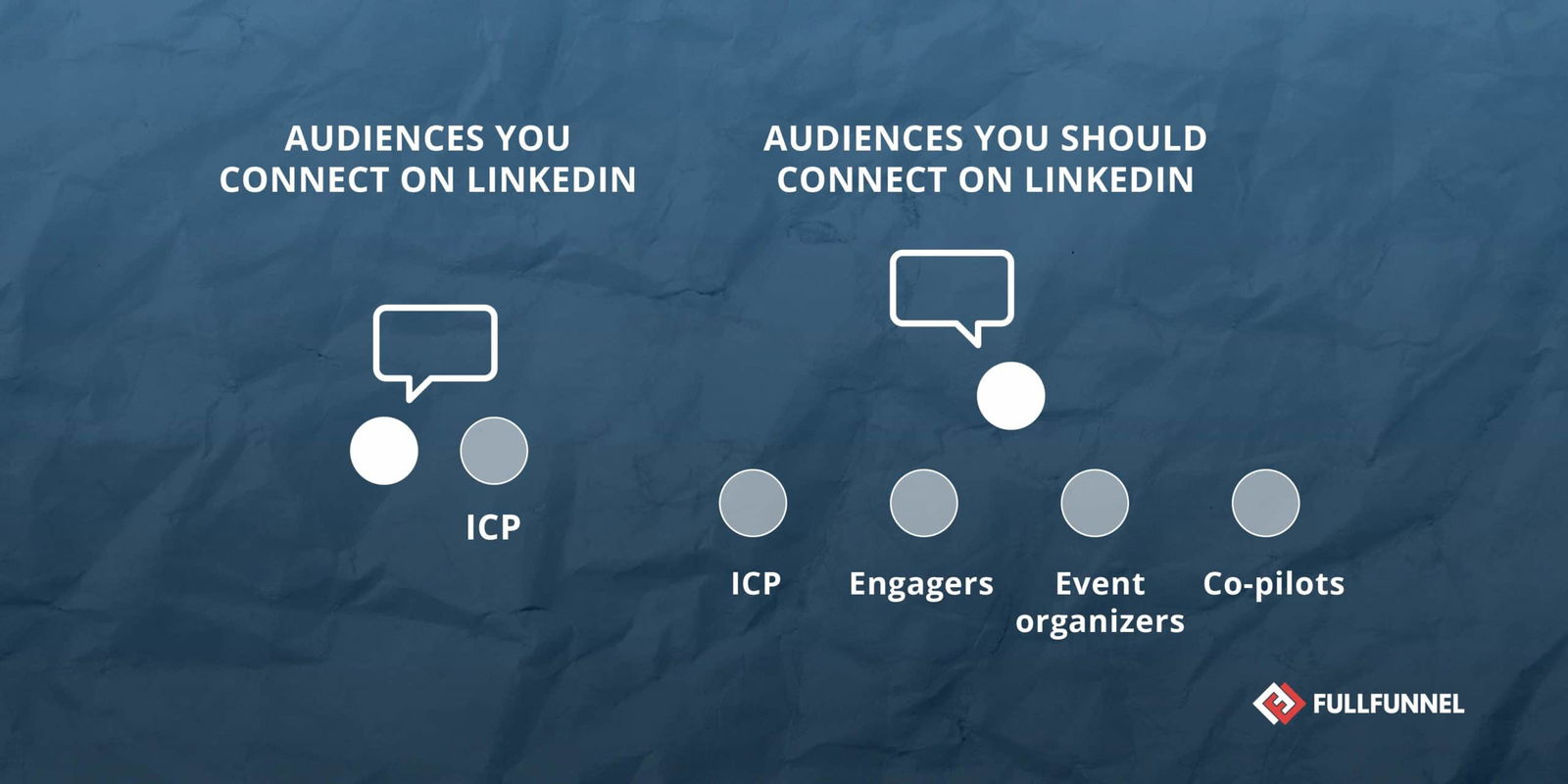
Mistake 4: Using cold, generic (and often automated) invitations to connect.
This is not only ineffective, but can hurt you in the long run. If too many people you invite to connect decline your invitation and report you by clicking “I don’t know this person”, LinkedIn will start requiring you to provide an email address for all your future invitations to connect.
This will effectively prevent you from proactively building your network.
But how can you connect with people without being spammy?
With Postindustria, we used the following approaches:
- Start a conversation in comments before inviting them to connect with you
- Look for mutual connections you have with those you want to connect with and ask them for an introduction
- Send personalized invites. Review their profile, posts, or website, and send a personalized invite
- Leverage shared interests: active community members, people following the same influencers, hobbies, location, attending the same university.
3. Warm up & nurture target accounts
Here are 3 steps we used to warm-up and connect with strategic accounts.
Step #1: Reach different buyers through a diversified content strategy.
Diversified content strategy means that the different team members were focusing on different buying committee members of their target accounts.
In Postindustria, the CEO was reaching out to executives and posting content dedicated to the CTOs or senior product engineers.
Their CMO was appealing to the marketing team and senior tech engineers. A senior architect was also occasionally posting tech content that is related to the IT department.
Here is why diversified content strategy is important:
- The more people inside your target prospect’s organization are aware of you and get to know you, the more likely it is that a sales conversation can be initiated
- LikedIn will display posts to your target buyers even if they are second or third grade connections if (1) your first connections liked or commented your post and (2) your post had descent engagement
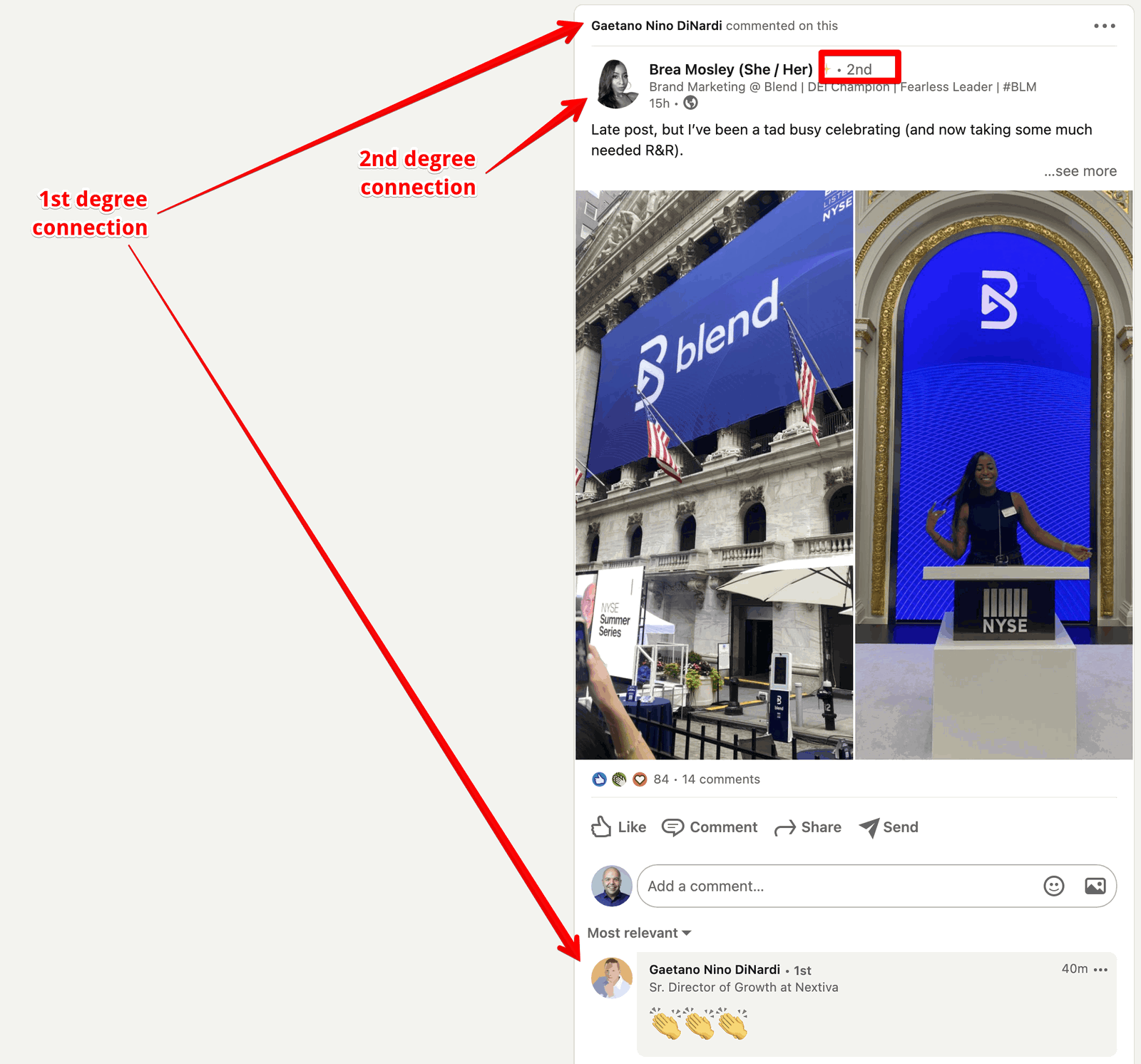
LinkedIn will display posts to your target buyers even if they are second or third grade connections
- There is no such thing as a one-size-fits-all content strategy. It has to be dedicated to a specific job role as it is very likely you will be dealing with multiple buyers
Step #2: Create a map of informational needs.
Map of Informational Needs is a document that summarizes all the topics, potential questions your target audience might have regarding your product or your services.
The key is to identify the topics in which your target audience is genuinely interested.
A Map of Informational Needs saves you time by helping you avoid irrelevant content that gets ignored.
Here are 5 key steps for creating the map of informational needs:
- Find out what topics your clients are interested in, what they are reading, and who they follow. All of these questions may be asked during a customer interview.
- Look for content related to those interests. E.g. search for thought leaders or influencers who are posting about those topics and analyze their content.Check the comments and questions people are asking them.
- List of questions from target communities.
- Pour through (virtual) events and conferences. Identify questions, agendas, and topics being discussed.
- Create the Map of Informational Needs. Summarize all the topics, subtopics and potential questions in a single spreadsheet. Use it to create your content plan, and when looking for topics to write about on LinkedIn.
The finest content demonstrates your expertise and addresses the concerns of your target audience.
Step #3: Create the content plan following the 40/40/20 strategy.
To keep audience engaged, we used the 40/40/20 content strategy.
Here is what this means:
- 40 percent of your posts should revolve around your expertise, where you may answer your audience’s queries and provide your framework, solutions, case studies, and so on.
- The other 40% should be devoted to engagement posts. For example, you can create a “listicle”-type post highlighting (and tagging) the industry influencers to follow in this segment. These listicles tend to generate more engagement, which is how you gain the attention of a new audience.
- The remaining 20% is allocated to posts about your product or offer. You may promote articles, use cases, and so on here.
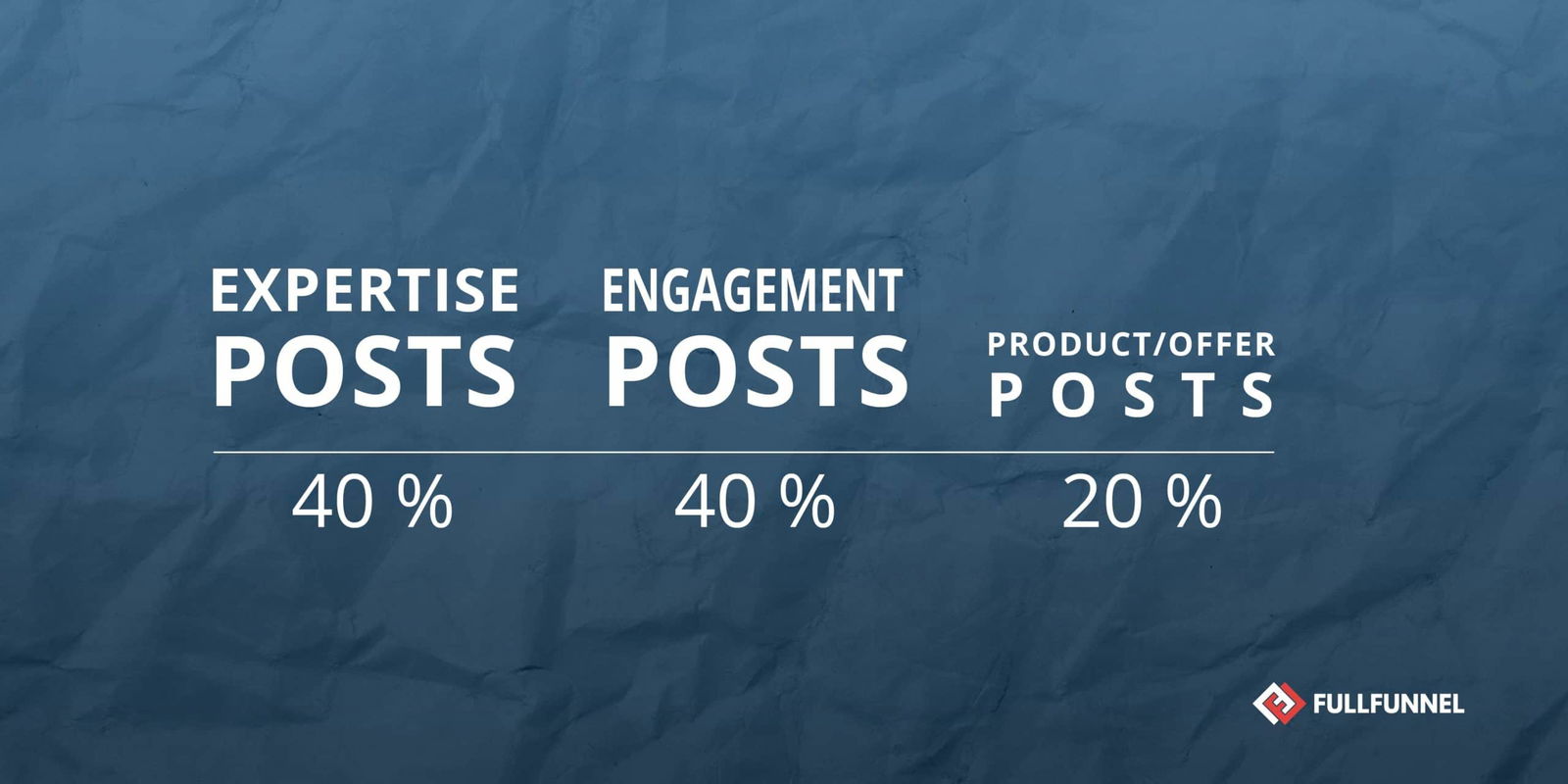
Step #4: Create a content production flow.
Over time, Postindustria has built a dedicated content creation process, involving a content agency:
- They have a dedicated content manager who manages the whole process (and are looking to hire another one)
- When we are talking about creation of content, it’s not only one person who’s a writer and who can write your content. The main thing you need is an expert opinion. So the content manager comes up with a list of ~20 topics and asks experts (e.g. engineers) for input. The engineers share short opinions and input about these topics
- Based on the input, the content agency produces the content. Postindustria is now hiring internal content writers
- Our content manager then works with a dedicated designers who produces images for the content
It’s interesting to see how Postindustria evolved their process and the key lessons they learned (taken from the interview with the company’s CMO):
- First content type was like, “OK, we have some ideas and thoughts about Ad Tech trends”. So we wrote about five posts about it. But we needed 50 posts, not five.
- The next step was to analyze the latest news — and not only the industry news, but also the latest news of our target accounts. So we created some posts and tagged our target audience on LinkedIn.
- We soon realized that we need somebody who will write a lot of content. So we hired a content agency. We share with them our ideas and they create content for us.
- In the next step, we realized that in addition to writers, we needed to hire a designer. In the beginning, we worked with a designer to create complex, infographic-type images, with lots of numbers. But over time it became clear that simple and clear, good-looking images were working as well, if not better — and come at a lower cost.
- Similarly, for content, we realized that 200-page white papers were not more effective than some of our shorter content.
Step #5: Set up an internal engagement pod.
Postindustria asked more than one hundred experts working for them if they wanted to help the company’s efforts on LinkedIn. About 30% of the team installed a special tool in their browser, that allowed the content manager to use the tool to arrange the different team members to like and comment on our posts.
This is important because of:
- Social proof: nobody wants to be the first one to like or comment on your post (If nobody likes it, why should I like it?). So having initial likes and comments will make the post seem more interesting to the target audience
- LinkedIn algorithm: the way that the algorithm works is that each new post is displayed to a small subset of people from your network, and based on the initial reactions, LinkedIn decides how much reach to give to each post (in principle, more initial reactions, more reach)
- Engagements boost organic reach: with the posts being displayed to your target audience and with decent engagement, you are more likely to get people from your target accounts to like or comment on your post. And these engagements matter because (1) their connections will see their likes or comments (2) the more they engage with your posts, the more LinkedIn will show them your new post
Stage 3: The Account-Based Market Research Campaign
As a part of the efforts to scale Postindustria’s LinkedIn demand generation strategy, we helped the team map out and set up an account-based market research campaign. It was a large campaign, including three audiences I mentioned earlier (the ICPs, engagers and co-pilots).
The campaign helped them to connect and engage more target buyers, created an expert industry report together with a market leader Open X, and positioned themselves as industry experts.
As a result of the partnership with Open X, they also got new collaboration opportunities. The insights they got from the market research also generated lots of content ideas for Linkedin.
Here is the overview of the process.
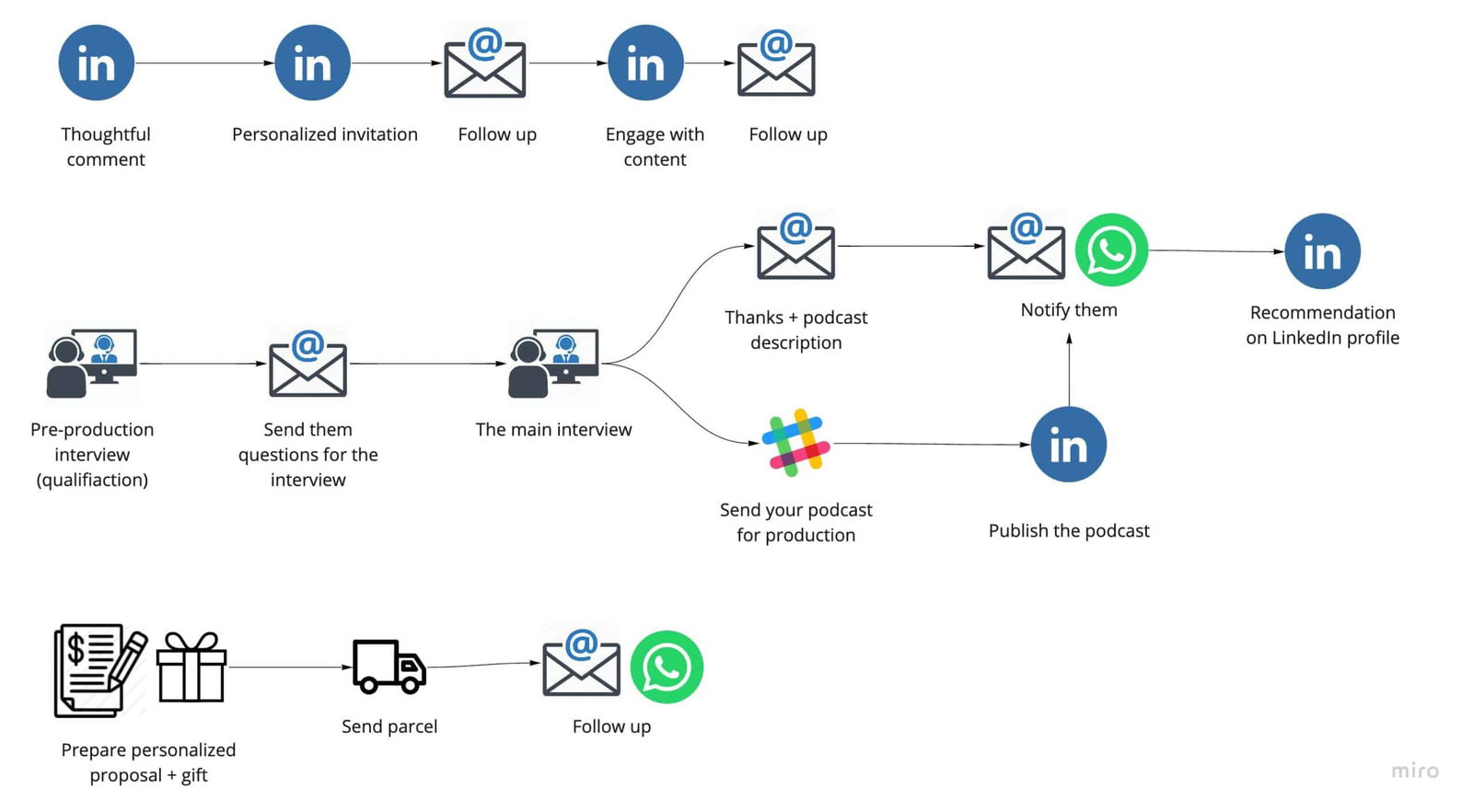
Connect & Qualify Campaign Blueprint
Essentially, you’re featuring your target accounts in an industry-relevant publication (e.g. industry report).
The “connect” part is about building relationships with the buyers through different touch points: the interview, a thank you message, a LinkedIn recommendation, the moment you publish your content etc.
But the most important part is qualification.
During the interview, you can ask them a bunch of qualification questions. That will not only allow you to identify a potential opportunity, but will also give you a lot of information to personalize your follow-up and your pitch.
In addition, with this work, you’re creating unique, expert content you can use to drive more awareness and to further engage your target accounts.
We describe the entire process in our 6-weeks ABM playbook.
Takeaways & Lessons Learned
Long-term thinking pays off
If you want to be successful, long-term thinking is essential. Many businesses have a win-now mindset, believing that ‘we need leads right now or revenue right now.’ And even if they try demand generation, they give up too early.
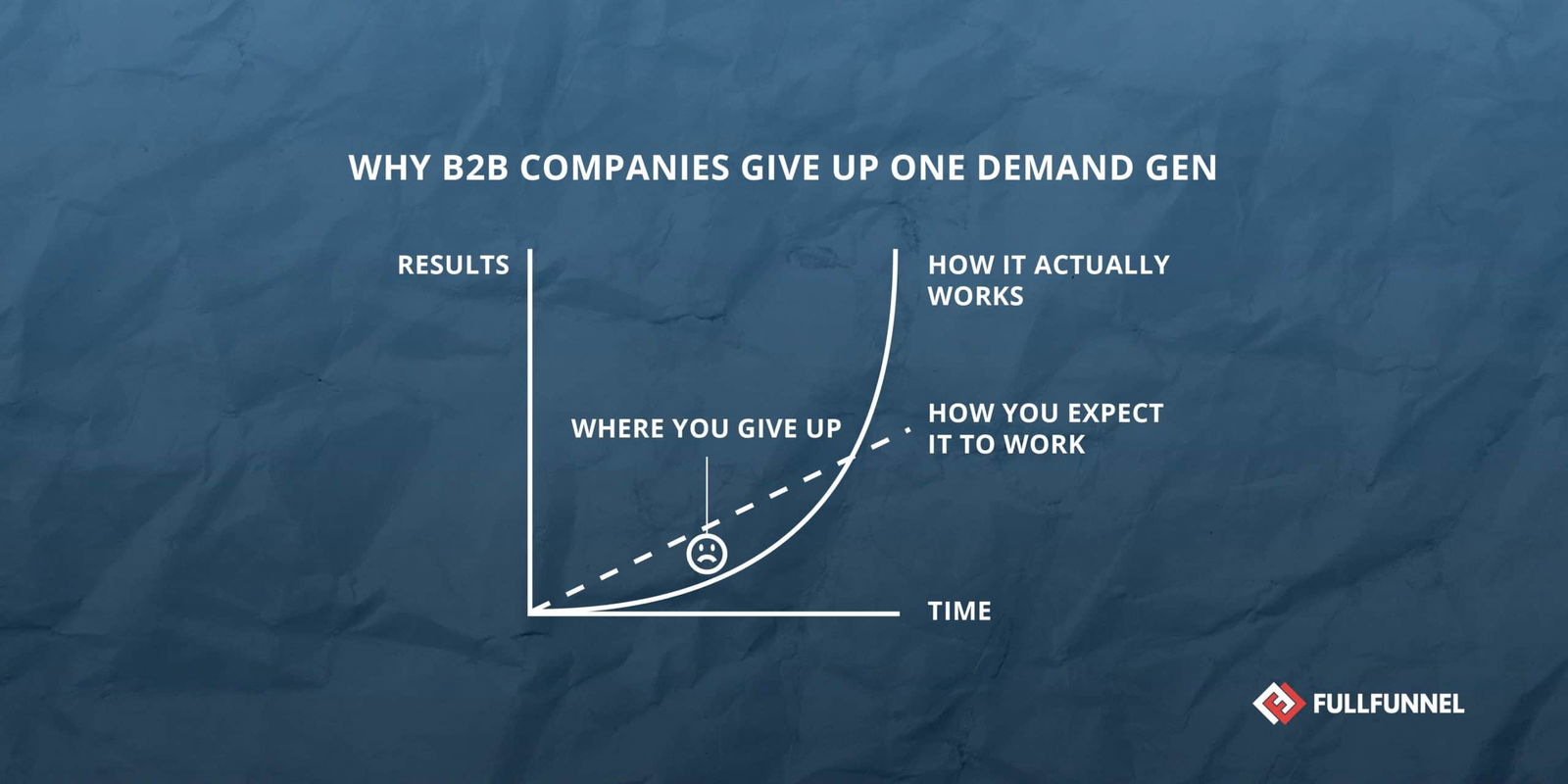
Why companies give up too early on demand generation
You must dedicate some effort to establishing a reputation.
Postindustria began with a list of accounts, which they then refined. In addition to receiving sales qualified opportunities and revenue from closed deals, Postindustria was gaining the advantage of establishing themselves as a specialist in this industry.
As Dmytro Kustov, the CMO put it during our interview where he shared his experiences about this campaign:
“LinkedIn is amazing. LinkedIn really works, and it works much better for B2B businesses with big contracts than ads or other channels.
We can concentrate all our focus, all our activities in LinkedIn, and it would still be cost efficient. LinkedIn is a really amazing tool, which would still have space for newcomers.”
The results compound over time
As a result of this strategy, Postindustria began to appear in the news feeds of businesses that were not previously on their list.
Since people were visiting their profiles, Postindustria was creating a wide range of opportunities that had a compound effect and resulted in:
- 9 qualified sales opportunities and 3 new contracts
- The annual contract value of these opportunities and contracts was ten times higher than the average value of contracts the company was signing up until then.
- Created a repeatable evergreen process they can easily scale and apply to other accounts and markets.
- Strategic partnership with a market leader
- Positioning of an industry expert
That is why we advise implementing a daily routine.
Because, with each day you repeat your routine, you’re growing your key assets (brand, awareness, skills, partnerships…), which in turn, have a multiplicative effect on everything you do.
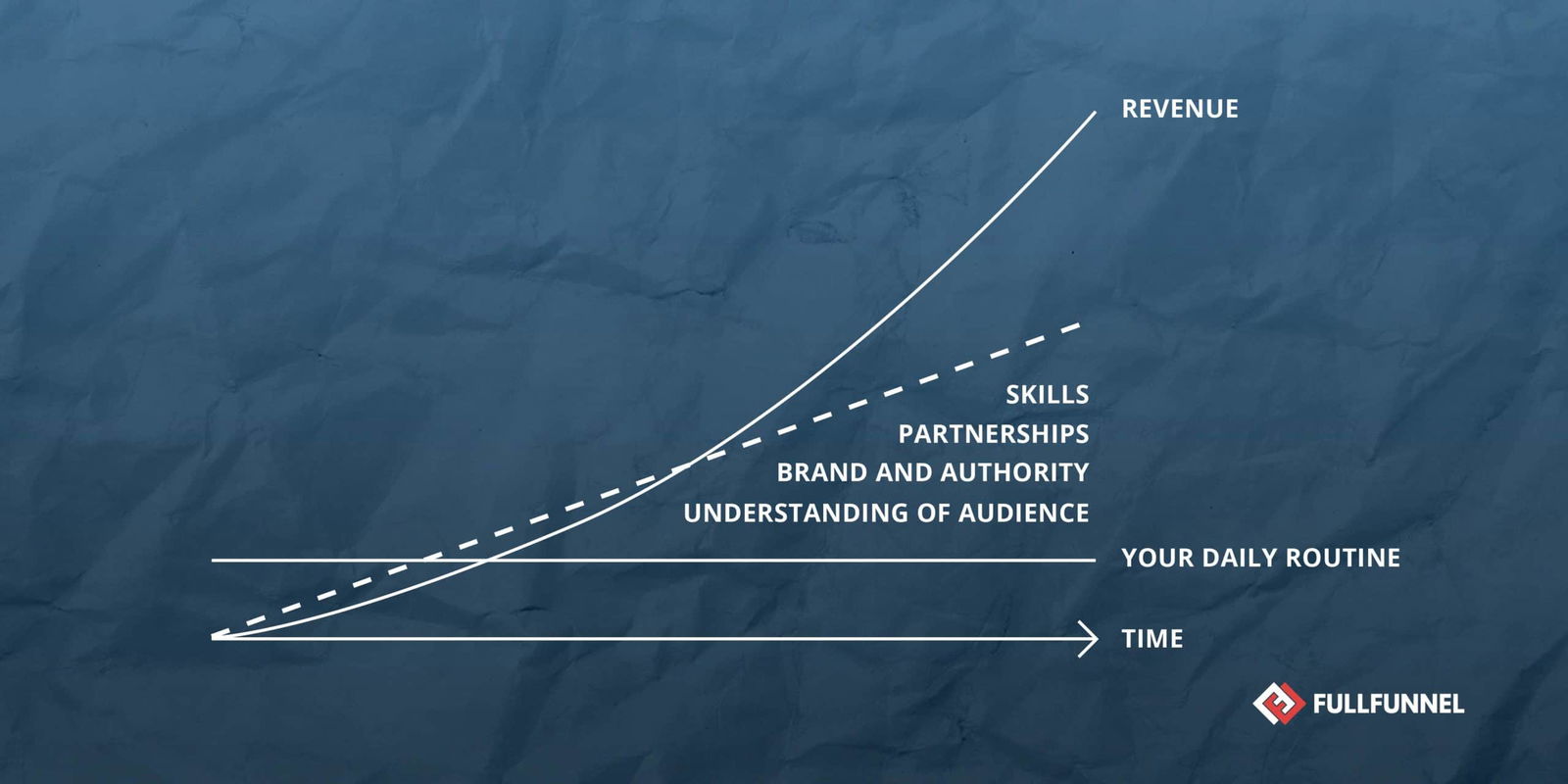
The compound effect of demand generation on LinkedIn
You need a proven process and a team
A lot of companies believe that you need to hang out on LinkedIn all day long, have 10.000+ followers, send hundreds of messages, or run expensive LinkedIn ads.
The truth is that you don’t need any of that.
You need a proven LinkedIn demand generation strategy and a process that positions you as a trusted advisor to your target audience, generates demand from the target accounts, connects & qualifies the members of your buying committee, and leverages engagement and buying signals to activate accounts.
And you need a team.
If you are an executive and you have one marketer or one product specialist, it’s enough to start, but the key to building a multi-million pipeline is building a team.
Bonus: Additional ideas
While the initial campaign as described above generated a multiple seven-figure pipeline filled with 10X ACV opportunities, here are two more ideas on how the campaign could be refined further and what we do with other clients.
Turn engagement & buying signals into conversations and opportunities
When is the best moment to start a sales conversation? When your prospects “raise their hand” through engagement and buying signals.
Here is how we monitored engagement and buying signals.
Start with Linkedin intent data. Check the views on your profile, the interaction with your posts, posts from your target accounts’ buying committee, signups to your events. You can also check if the buyers are attending your webinars or visiting your site.
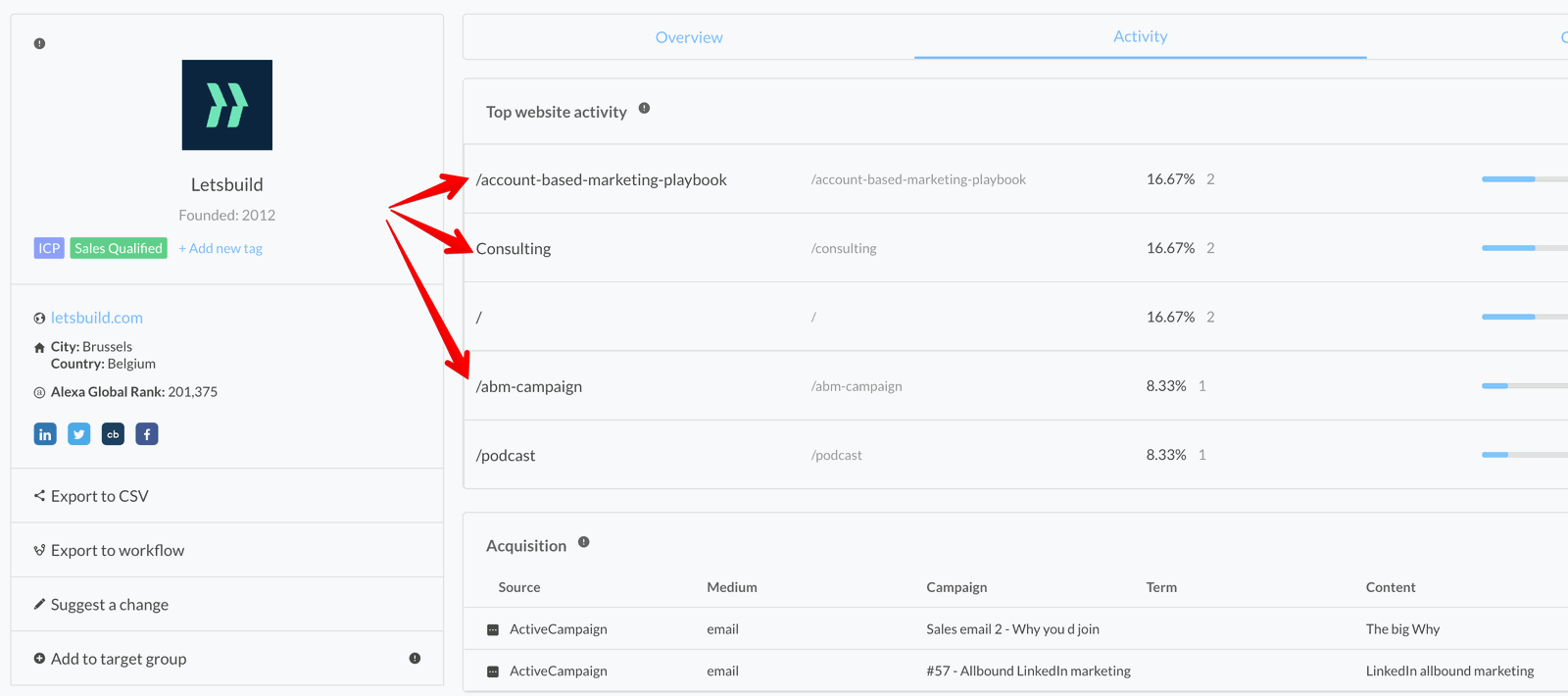
Use IP Identification software to know when target accounts visit your website
You need to consider these as engagement triggers, and build on the initial engagement. For example, you may start non-sales conversations, send them a video message, share a case study, invite them to an interview to feature them in content you’re creating or to an event you’re running.
Let the prospects control the relationship — but watch for signs that they may be ready for more.
We call these signs the buying intent signals: E.g. visits to key pages on your website. Reading your bottom-of-the funnel content.
I also recommend that you monitor the buying signals and identify the accounts that have a need. Monitor their posts, news and announcements on a regular basis — and if there is a signal, it is time to contact them. For example, tech businesses make their roadmaps public so that you can see what features they are working on.

Monitor announcements, news, published roadmaps
By tracking public data, you will gain knowledge and understand how to assist them, which will serve as an excellent foundation for reaching out. LinkedIn polls can also be used to gather purchasing signals.

Using LinkedIn polls to gather purchasing signals
You need a list and a tracking system in place so that you may contact them at the appropriate time. Remember that personalisation generates sales qualified leads.
Never stop nurturing
Unfortunately, most of your market is not ready to buy. It may take a lot of touch points and a long time before a contact becomes an opportunity. And LinkedIn is a powerful tool to help you stay on their radar so they think of you when they are.
Here’s a recent example:
- First contact: Oct 2020
- Account activated: May 2021
- # touch points: 19 conversations and probably as many LinkedIn post engagements (I expect at least another dozen or two before the deal is closed)
A common misconception is that “if on average I need X touch points, this is how many times I need to message or email my prospects”.
First, not your messages will be read. And even those that are read may not be relevant or timely.
Second, warm prospects usually engage on different channels and with different types of content: Emails, LinkedIn posts, webinars, content hubs, podcast interviews…
So, instead of asking how many touches you need, do this:
- Never stop nurturing
- Leverage different channels and types of content
- Keep building the relationship using non-sales touches
- Be patient
Takeaways and next steps
As you see, orchestrating and executing an effective LinkedIn demand generation strategy takes time and resources but if the campaign is done right the ROI might be huge.
The budget for orchestrating and executing this campaign (without our fee and salaries) was less than $10k, so the campaign ROI was more than 50.000%.
Of course, not every campaign generates the same results, and the results don’t come immediately, but demand generation and account-based marketing are the only way to grow complex B2B businesses.
Support
If the case study was valuable, please, retweet my thread featuring the case study below, so more B2B marketers and execs could discover it. Thank you.
Want to generate a 7-figure pipeline with a budget under $10k?
— Andrei Zinkevich (@AZinkevich) November 17, 2021
Here is a step by step process we used for a software development company to generate:
— 9 qualified sales opportunities
— 3 new contracts with 10x ACV (average contract value)
— $5mln pipeline
[Thread] 🧵👇
Next steps
1/ If you need help with launching demand generation programs, book a call here or pm me on LinkedIn. You can learn more about our services here.
2/ If you learned something new from this case study, then you’ll love our Allbound LinkedIn Marketing Playbook.
We share our entire demand generation process and teach a simple 1-hour daily routine that:
- positions you as a trusted advisor and expert
- generates inbound leads
- builds relationships with your target audience




